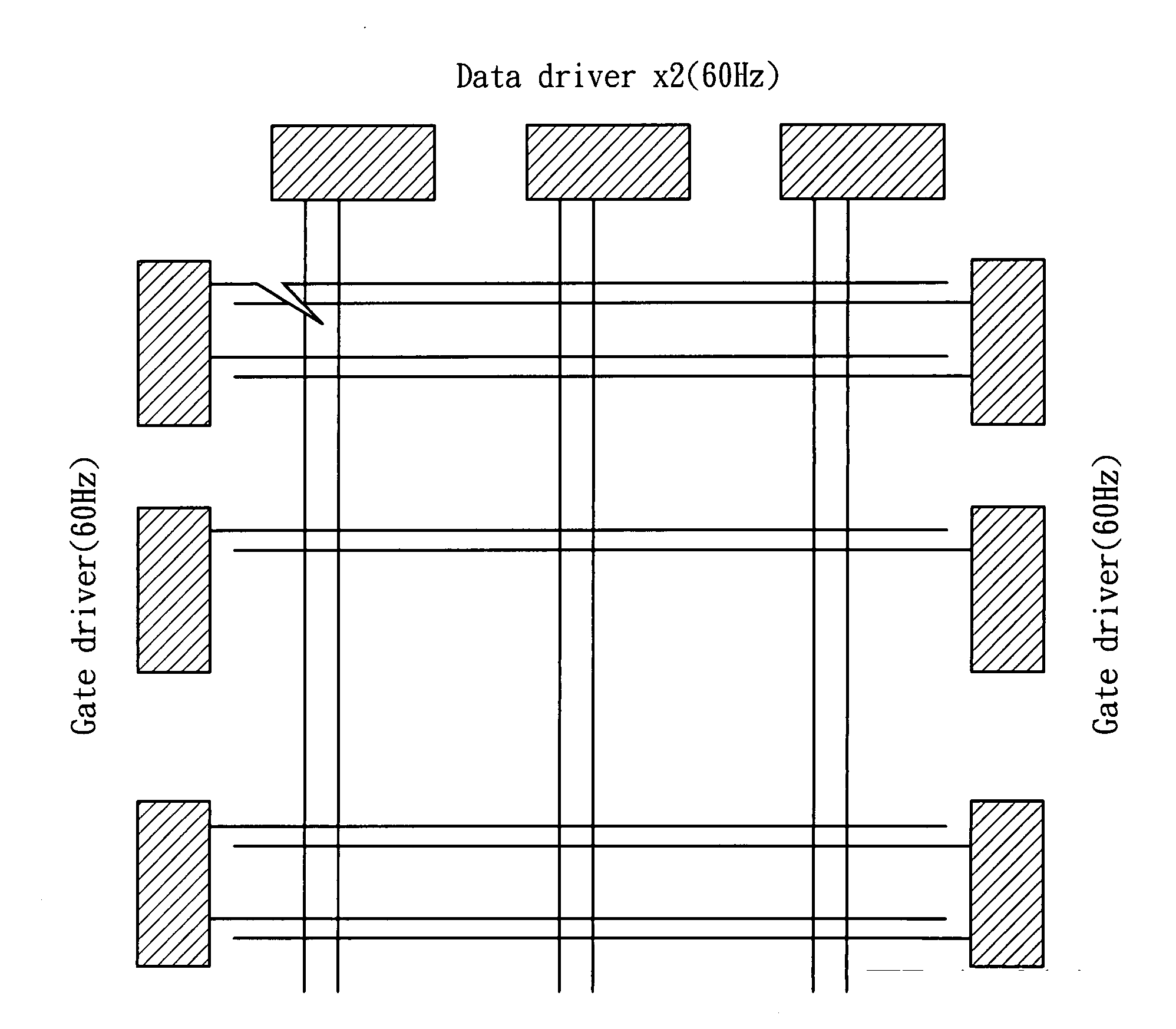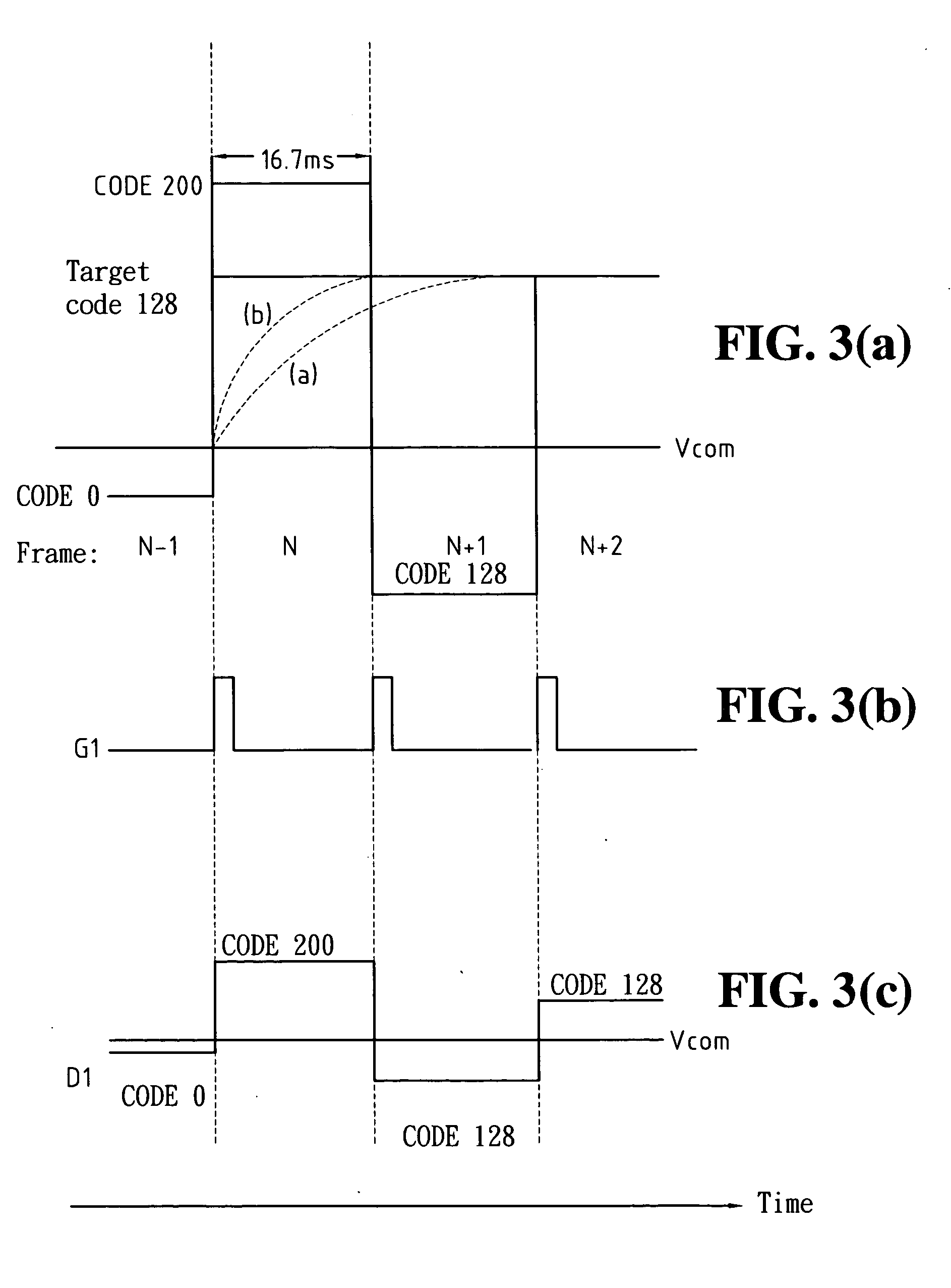Method and device for driving liquid crystal display
a liquid crystal display and display technology, applied in the field of liquid crystal display, can solve the problems of delay phenomenon, liquid crystal molecules, and require a period of time to develop targeted orientations, etc., and achieve the effect of fast optical response time, superior quality and fast changing
- Summary
- Abstract
- Description
- Claims
- Application Information
AI Technical Summary
Benefits of technology
Problems solved by technology
Method used
Image
Examples
first embodiment
of the Present Invention
[0032] The first embodiment of the present invention is described in the following along with FIGS. 4(a) and 4(b) and FIGS. 5(a) to 5(e).
[0033] FIGS. 4(a) and 4(b) are schematic diagrams showing the overdrive device and an inner structure of a pixel at the intersection of a plurality of gate lines and data lines according to the first embodiment of the present invention.
Driving Device of the First Embodiment of the Present Invention
[0034] As shown in FIG. 4(b), the pixel structure of the overdrive device according to the present invention comprises a firs gate line G1, a second gate line G1′, a first data line D1, a second data line D1′, a first capacitor Cs connected to the ground as a storage capacitor, a second capacitor CLC also connected to the ground representing the equivalent capacitance of liquid crystal, an output line (not shown in FIG. 4(b)) for delivering the output overdrive voltage (VLC) to the a corresponding pixel on the LCD display, a fi...
second embodiment
of the Present Invention
[0047] The second embodiment of the present invention is described in the following along with FIGS. 6(a) and 6(b) and FIGS. 7(a) to 7(g).
[0048] FIGS. 6(a) and 6(b) are schematic diagrams showing the overdrive device and an inner structure of a pixel at the intersection of a plurality of gate lines and data lines according to the second embodiment of the present invention. Driving device of the second embodiment of the present invention
[0049] As shown in FIG. 6(b), the pixel structure of the overdrive device according to the present invention comprises a firs gate line G1, a second gate line G1′, a first data line D1, a second data line D1′, a first capacitor Cs connected to the ground as a storage capacitor, a second capacitor CLC also connected to the ground representing the equivalent capacitance of liquid crystal, an output line (not shown in FIG. 6(b)) for delivering the output overdrive voltage (VLC) to a corresponding pixel on the LCD display, a firs...
third embodiment
of the Present Invention
[0062] The third embodiment of the present invention is described in the following along with FIGS. 8(a) and 8(b) and FIGS. 9(a) to 9(d).
[0063] FIGS. 8(a) and 8(b) are schematic diagrams showing the overdrive device and an inner structure of a pixel at the intersection of a plurality of gate lines and data lines according to the third embodiment of the present invention.
Driving Device of the Third Embodiment of the Present Invention
[0064] As shown in FIG. 8(b), the pixel structure of the overdrive device according to the present invention comprises a firs gate line G1, a first data line D1, a first capacitor Cs connected to the ground as a storage capacitor, a second capacitor CLC also connected to the ground representing the equivalent capacitance of liquid crystal, an output line (not shown in FIG. 8(b)) for delivering the output overdrive voltage (VLC) to a corresponding pixel on the LCD display, a first transistor Q1 having its gate connected to the f...
PUM
 Login to View More
Login to View More Abstract
Description
Claims
Application Information
 Login to View More
Login to View More - R&D
- Intellectual Property
- Life Sciences
- Materials
- Tech Scout
- Unparalleled Data Quality
- Higher Quality Content
- 60% Fewer Hallucinations
Browse by: Latest US Patents, China's latest patents, Technical Efficacy Thesaurus, Application Domain, Technology Topic, Popular Technical Reports.
© 2025 PatSnap. All rights reserved.Legal|Privacy policy|Modern Slavery Act Transparency Statement|Sitemap|About US| Contact US: help@patsnap.com



